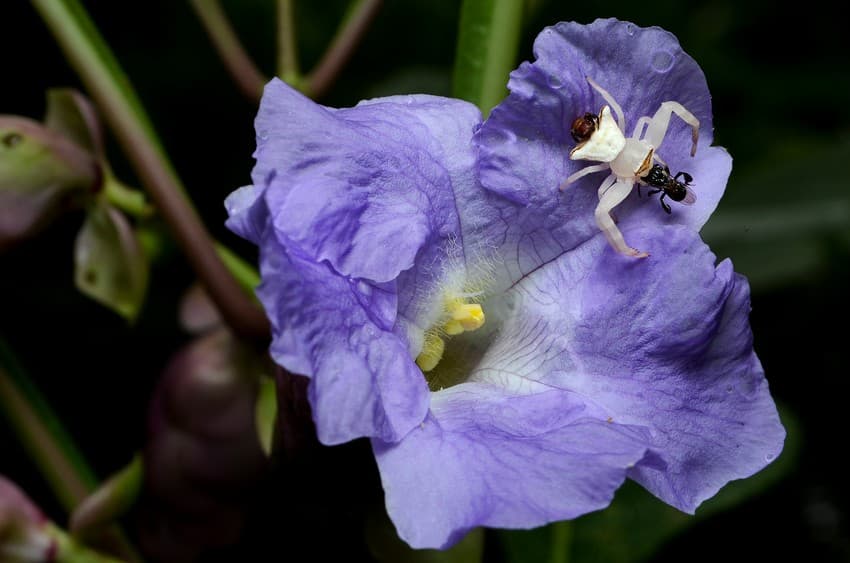September of 2016. A brief break from the rains, a bit of sunshine. Mumbai’s Sanjay Gandhi National Park shimmered with various shades of green. Being a naturalist partial to the understory, I found myself in the Nagla Block, the northern end of the park, on a trail favoured by the lovers of butterflies and other insects. On almost every other leaf, was a life-form going about important business. At every other step, the understory offered a lesson in ecology: a caterpillar feeding on a plant that its mother must have carefully chosen, tasting it with her feet; one moth mimicking bird faeces, another a broken twig; a chocolate pansy butterfly feeding on bird faeces for essential nutrients not found in nectar; a grass demon butterfly uncurling its long proboscis to reach the nectary of the gramophone-shaped flower of crepe ginger; a spider silk-wrapping its prey for dinner; a brood of gregarious moth caterpillars together trying to look like a menacing twenty-legged tarantula; and so much more. But I had come for some special flowers, and the dramas that might unfold around them. I had waited for seven years, and so had the plant. This was the mass-flowering year of the shrub called Karvi. I hurried to the last section of the trail, where Karvi dominates the understory.

While a female crab spider is busy feeding on a freshly-killed bee, the male, which is darker and disproportionately smaller, takes the opportunity to copulate without running the risk of being eaten. (Photo by Rizwan Mithawala)
The green of the understory appeared to wear a violet veil. Pink-white buds had appeared all over and opened en-masse in shades of lavender – a nectar bar for butterflies and bees. I photographed many species of butterfly sipping from the flowers, and bees leaving the flowers with their pollen bags full. But then something caught my eye – a crab spider, a predator of pollinators that lurks around flowers to ambush visiting insects. But this one was not hiding. A white-coloured female, she perched on the petal of a Karvi flower, feeding on a fresh kill: a stingless bee. She must have ambushed the bee inside the flower, and had then walked out to eat, even as other bees continued to whizz in and out of the same flower. But there was more drama to the scene. While the huntress was busy injecting digestive fluids into the bee and turning its body tissues into soup, a male of her species had found an opportune moment – to copulate without getting eaten!
Safe sex takes a whole new meaning if you are a male spider. Sexual cannibalism by females is widespread, and the much smaller males have evolved many a tactic to dodge death. Self-amputating a foreleg and offering it to the female, or tying her up with silk, is as weird as it can get. Males of many species have also evolved opportunistic mating strategies to take advantage of a safe sex window, when the female is least likely, or not likely at all, to attack. Our crab spider male chose to mate when his ladylove was having a meal. Another way to mate opportunistically is to make your move when the female is moulting. This is when her exoskeleton is soft, and she is unable to move and attack. A study involving laboratory experiments as well as field observations of the sexually cannibalistic orb-weaving wasp spider (Argiope bruennichi) revealed that copulations with moulting females could result in 97% male survival, compared to only 20% when her exoskeleton is hard.
Looking at the dramatic scene through the viewfinder, I felt in awe of nature’s play of life and death. The bee was dead, but because of that, the male spider was going to survive this mating, and maybe even find another female to pass on his genes. Just when I thought I had made enough pictures of the love-death triangle of two spiders and a dead bee, it began to drizzle. I took the camera off my eye and began wiping raindrops from the lens. When I looked up again, the female spider was still feeding on the bee; the male had fled the scene.
——————————————————————————————————————————————————————
About the author: Rizwan Mithawala is a Conservation Writer with the Wildlife Conservation Trust and a Fellow of the International League of Conservation Writers. He has previously worked as an environment journalist with a national newspaper.
Disclaimer: The author is associated with Wildlife Conservation Trust. The views and opinions expressed in the article are his own and do not necessarily reflect the views and opinions of Wildlife Conservation Trust.
——————————————————————————————————————————————————————
Your donations support our on-ground operations, helping us meet our conservation goals.
——————————————————————————————————————————————————————
Related Links
- In Praise of Spider Silk
- Tide Pool Life
- A Preventive Healthcare Safari for Conservation
- Plastic Runs Deep
- Manipulative Frankensteins
- Baby sloth bear rescued from barbed wire fence in MP

